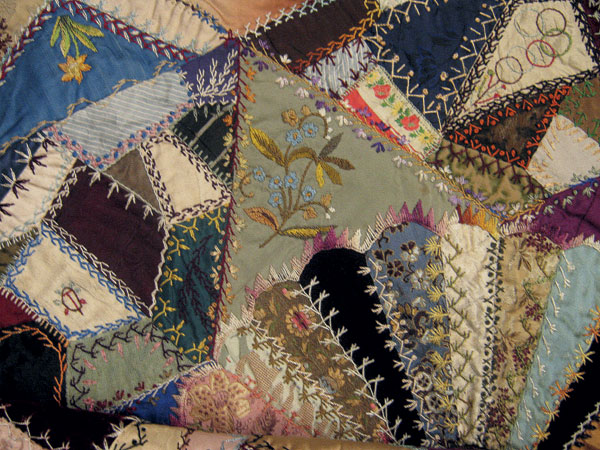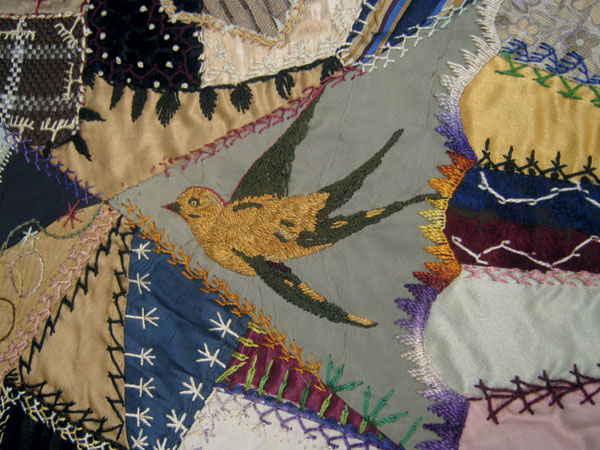
Stories in the Seams – Tales of Antique Textiles and Quilts
Helen L. Sheppard Dounce Crazy Quilt
By Virginia Vis — Volunteer Curatorial Assistant, Daughters of the American Revolution Museum
Elaborate, complex, decorative — gaudy? The beauty of a crazy quilt is in the eye of the beholder. They’re composed of irregular-shaped fabric pieces sewn either to a foundation fabric or to each other in a haphazard fashion, and the skill of the maker can create something that looks as elegant as faceted jewels or as messy as a pile of broken pottery. Some historians have erroneously identified crazy quilting as the first kind of patchwork, believing needlewomen with scant access to fabric made scrap quilts out of necessity, but there are no known examples earlier than the late 19th century.
These textiles have always been a symbol of extravagance. While rare cotton versions are known, most crazy quilts use fine fabrics such as silk, velvet, wool and brocade. Meant to decorate the parlor, not the bedroom, many also flaunt the needlewoman’s skill at embroidery and painting. To produce one required extra income for materials and free time to spend stitching it. At the height of the mania, during the mid-1880s, newspaper articles, poetry and songs decried women abandoning their responsibilities to sew one more patch or embroider over one more seam.
Feeding the fervor for fancy work was America’s interest in all things oriental following the end of Japan’s isolationist policy. The Japanese pavilion at the Philadelphia Centennial Exposition in 1876 showed that country’s artwork, textiles and pottery with a “crazed” or “cracked ice” glazed surface. Existing crazy quilts that date from before the exposition show the fad itself began earlier, but it spread like wildfire, along with the publicity surrounding the exotic objects on display. Contemporary names for the technique included “puzzle patchwork”, “mosaic” and “Japanese patchwork”.
Fabric manufacturers, aided by a drop in silk fabric prices, jumped on the bandwagon by selling bags of fine fabric scraps perfect for crazy patchwork. Many promised there were no two pieces alike in the selection to ensure a diversity of materials beyond the maker’s own sewing basket.
Patterns to embroider or paint were also commercially available, mixing as eccentrically as the fabrics. Exotic tigers and elephants appeared beside house cats and chickens. Geishas frolicked with the bonneted children made popular by author and illustrator Kate Greenaway. Spring crocus bloomed among autumn pumpkins. New technologies, like the bicycle, were featured next to nature’s creations, like the spider web. Meandering lines of elaborate stitching often enclosed all. For the quilt maker with more enthusiasm than skill, professionally embroidered motifs could be purchased to be appliqued to a patch with simple sewing.
While the crazy quilt made by Helen L. Sheppard Dounce is undated, the large “G” in the center may give us a hint. The family member who donated the quilt to the DAR believed this represents the married name of Helen’s eldest daughter. Jeanette E. Dounce married William Gerity in December, 1872, so Helen’s quilt may have been made for or after that happy event. An included commercially printed ribbon declaring “Merry Christmas” placed prominently near the centre may also support the family connection. However, the quilt descended through Helen’s sister, Caroline Sheppard Herrick, and was given to the DAR by Caroline’s granddaughter, Virginia Mayo Herrick.
The “G” is surrounded by a wheel of scalloped wedges — or are they Japanese fans? A field of crazy patchwork surrounds the centre, with orderliness reestablished by a blue and pink sawtooth border.
Make the Crazy Log Cabin Quilt
Despite the desired randomness of crazy quilts, they appear in two formats. The whole-cloth version spreads the pieces completely haphazardly across the entire expanse. This method often becomes heavy and unwieldy to work on. When done in smaller sections or blocks, that are afterwards joined together, the result is a “contained” crazy. Some use sashing to further emphasise the block format.
By working with large diamond shapes, along with a few triangle “spacers”, Helen had manageable sections to sew on. When connected, they blended into a more diffuse design. She began in the centre with a symmetrical circle of diamonds around the centre wheel, but things go awry as the diamonds radiate out. Some line up into rows, others orientate in new directions. Several contain fan-shaped sections constructed like her centre, others are composed of random pieces. The diagonal lines of the diamonds, even when outlined with embroidery, disguise the construction method. This tricks, confuses and delights the eye.
In addition to the embroidery in the interior, the triangles in the sawtooth border each contain an embroidered motif. A variety of animals, birds and flowers are depicted. Duplicates of the same motifs show Helen utilised attainable patterns.
With their numerous seams, crazy quilts cannot be quilted in the traditional sense. Some are left unbacked completely, exposing the foundation fabric. Many have a single layer of fabric attached. Others use the standard “sandwich” of top, batting and backing but connect the layers with ties of thread, yarn or ribbon. Helen chose a common method of prequilting an appropriate fabric and using that as a backing for the patchwork. Her backing is a blue silk, quilted in a grid formation, sadly now badly deteriorated.
Learn Precise Machine Appliqué and Foundation Piecing
The disintegration of her backing also “dates” Helen’s quilt. In the late 1800s, silk fabric was often sold by weight rather than linear measurement. Manufacturers increased their profit margins by adding lead salts to their dyes, making the fabric weigh more. These same lead salts gave silk dresses of the period the desired rustle, called “scroop”. Sadly, over time, the process ruins the fabric, causing the fibres to break down. This is irreversible and unpreventable.
Fortunately for us, Helen used few of those fabrics in her top, allowing us to continue to enjoy her intricate piecing and embroidery.
Helen L. Sheppard Dounce Crazy Quilt, about 1880-1900
The Daughters of the American Revolution Museum, Permanent Collection (ID — 86.47)
67 3/8in wide by 72in long, made by Helen L Dounce, New York, NY.
Gift of Virginia Mayo Herrick.





